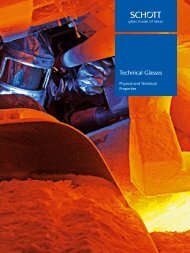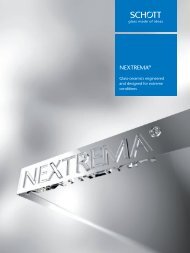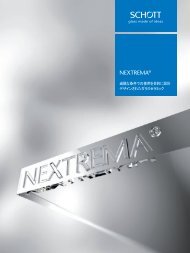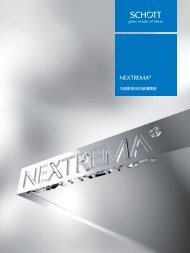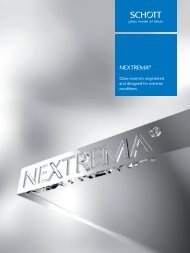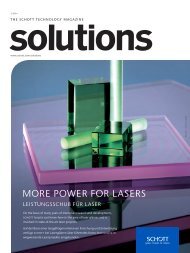Technology Magazine "SCHOTT solutions" - Edition 2/2013 - Technologie Magazin "SCHOTT solutions"
A variety of SCHOTT innovations The latest issue of our technology magazine “solutions” discusses innovations our SCHOTT experts are developing, how they provide support for our customers as partners and how they are addressing tomorrow’s challenges today. Our broad range of products and materials opens up a wide variety of different topics ranging from the universe all the way to the nano cosmos. We wish you enjoyable reading! Spannende Stories über SCHOTT Innovationen Die neuste Ausgabe des Technologiemagazins „solutions“ verrät, was SCHOTT Experten entwickeln, wie sie Anwendern kompetenter Partner sind und die Herausforderungen von morgen schon heute anpacken. Unsere breite Produkt- und Materialpalette erschließt dabei ein weites Feld: vom Weltall bis in den Nanokosmos. Viel Spaß beim Lesen!
A variety of SCHOTT innovations
The latest issue of our technology magazine “solutions” discusses innovations our SCHOTT experts are developing, how they provide support for our customers as partners and how they are addressing tomorrow’s challenges today. Our broad range of products and materials opens up a wide variety of different topics ranging from the universe all the way to the nano cosmos. We wish you enjoyable reading!
Spannende Stories über SCHOTT Innovationen
Die neuste Ausgabe des Technologiemagazins „solutions“ verrät, was SCHOTT Experten entwickeln, wie sie Anwendern kompetenter Partner sind und die Herausforderungen von morgen schon heute anpacken. Unsere breite Produkt- und Materialpalette erschließt dabei ein weites Feld: vom Weltall bis in den Nanokosmos. Viel Spaß beim Lesen!
You also want an ePaper? Increase the reach of your titles
YUMPU automatically turns print PDFs into web optimized ePapers that Google loves.
SMART FIBER OPTICS FOR<br />
USE IN MODERN RADIOLOGY<br />
SMARTE FASEROPTIK<br />
FÜR DIE MODERNE RADIOLOGIE<br />
Sophisticated dynamic or 3-D x-rays would be impossible without using state-of-the-art flat image<br />
detectors that feature fast CMOS sensors. New RoHS-conforming fiber optic plates that offer high<br />
transmission and x-ray attenuation support this trend.<br />
Anspruchsvolles dynamisches oder 3D-Röntgen gelingt nur mit modernsten Flachbilddetektoren auf Basis<br />
von schnellen CMOS-Sensoren. Diesen Trend unterstützen neue, RoHS-konforme Faserplatten mit hoher<br />
Transmission und Röntgendämpfung.<br />
THILO HORVATITSCH<br />
T<br />
oday, 3-D x-ray devices that rotate around a patient’s jaw and<br />
produce many different individual images that can be joined<br />
together on the computer to form three-dimensional images are<br />
quite commonplace in progressive dental practices. They make it<br />
possible for implants to be aligned down to the millimeter and<br />
sometimes discover a few surprises. Both this technology and<br />
digital x-rays are rapidly gaining ground in operating rooms. Here,<br />
a series of photos are taken, which then appear on the screen as<br />
continuous image sequences – a type of live control for surgeons.<br />
The fascinating imaging techniques that are used in modern<br />
radiology open up new diagnostic possibilities, enable difficult<br />
surgical procedures and significantly improve their chances of success.<br />
This can all be attributed to digital x-ray technologies that are<br />
replacing analog techniques. Time-consuming development of<br />
film is now a thing of the past. Instead, these images are recorded<br />
either directly or via image sensors and then digitalized so that they<br />
can be accessed and distributed very quickly by computer. Digital<br />
technology is also much more light-sensitive, has short exposure<br />
times and allows for an entire series of images to be produced. At<br />
the same time, it reduces radiation often by as much as 90 percent<br />
compared with traditional x-rays.<br />
Advanced technology is what makes this possible. Digital x-ray<br />
devices can be divided into direct and indirect flat image detectors<br />
that record and convert the radiation from x-ray tubes into digital<br />
I<br />
n fortschrittlichen Dentalpraxen rotieren bereits 3D-Röntgengeräte<br />
um den Kiefer eines Patienten und erzeugen dabei<br />
viele Einzelaufnahmen, die im Computer zu dreidimensionalen<br />
Bildern zusammengesetzt werden. Implantate lassen sich so millimetergenau<br />
ausrichten, manche Besonderheiten erst entdecken.<br />
Auch im OP-Saal ist diese Technik im Kommen, ebenso wie das<br />
sogenannte dynamische Röntgen. Dabei werden in kurzer Zeit<br />
Fotoserien geschossen, die am Monitor als fortlaufende Bildsequenzen<br />
erscheinen – eine Art Live-Kontrolle für den Chirurgen.<br />
Diese faszinierenden Bildgebungsverfahren der modernen Radiologie<br />
eröffnen neue diagnostische Möglichkeiten, erleichtern<br />
komplexe Eingriffe und steigern deren Erfolgschancen beträchtlich.<br />
Grundlage dafür ist der Einzug digitaler Röntgentechnologien<br />
und die Ablösung analoger Verfahren. Dabei entfällt die zeitraubende<br />
Filmentwicklung; stattdessen werden die Aufnahmen<br />
direkt oder über Bildsensoren erfasst und digitalisiert – rasch<br />
abrufbar und verteilbar per Computer. Die digitale Technik ist<br />
zudem wesentlich lichtempfindlicher und hat kurze Belichtungszeiten<br />
und Bilderserien erst ermöglicht. Zugleich verringert sie die<br />
Strahlenbelastung im Vergleich mit dem klassischen Röntgen, zum<br />
Teil um bis zu 90 Prozent.<br />
Dahinter steht ausgefeilte Technik: Digitale Röntgengeräte<br />
lassen sich unterteilen in direkte und indirekte Flachbilddetektoren<br />
zur Erfassung und Umwandlung der Strahlung aus Röntgenröhren<br />
35






